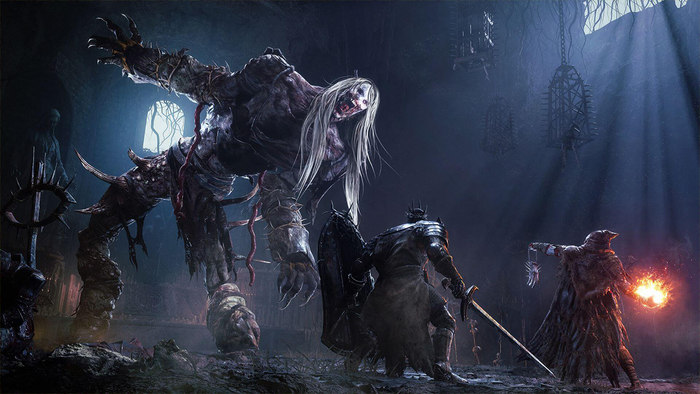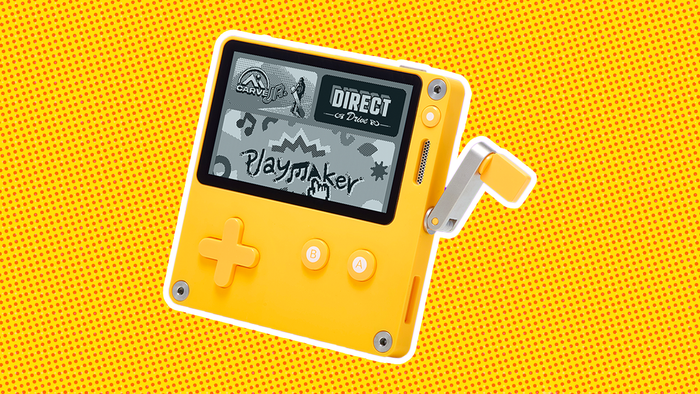Wizard's Warehouse: The Magick of Retail is an adventure in fantasy sales, having players scan armor, weapons, and potions for wizards and warriors.

Alt.Ctrl.GDC is dedicated to games that use alternative control schemes and interactions. Gamasutra will be talking to the developers of each of the games that have been selected for the showcase
Wizard's Warehouse: The Magick of Retail is an adventure in fantasy sales, having players scan armor, weapons, and potions for wizards and warriors.
Gamasutra sat down with developer Mike Salyh to talk about the challenges of turning a piece of retail equipment into a controller, how to create fun with something typically used for work, and how some past on-the-job memories would lead to this unique controller.
Sorcerous manager
I’m Mike Salyh, and I am the sole developer of Wizard’s Warehouse: The Magick of Retail. I designed the gameplay, programed the software, and assembled the props. It wouldn’t be fair to call this game a “one man effort” though; almost all of the visuals, sounds, and music were sourced from stock assets. There are so many high quality assets for sale these days; the challenge is combining them into a cohesive game. I enjoyed that task most of all.
I got my start making web games on Newgrounds.com while I was in college. When Flash lost popularity, I transitioned to mobile and got the chance to work for Disney and later Zynga. I learned a lot about game development over those years, but I wasn’t as passionate about mobile games as I had been with Flash.
In 2017, I decided to try something new and partnered with Two Bit Circus to design an escape room. I loved it and knew that I wanted to keep making out-of-home games. Today, I’m the co-founder of Coin Crew Games, a startup that designs multiplayer arcade machines.

Fantasy retail
Wizard’s Warehouse is a collaborative shopkeeping game that's played with handheld barcode scanners. Cards depicting medieval items like swords, potions, and meats are laid out on a big table. Most of the cards are placed in plain sight, but some are hidden in the drawers of a wooden chest.
Customers appear on a digital screen, each with a shopping list. The goal of the game is to find and scan the goods they’re after. Everyone must work together in order to serve as many customers as possible before time runs out.
Wizard's tools
Wizard’s Warehouse was developed entirely in Unity. The barcode scanners communicate over Keyboard Wedge protocol, so I didn’t need to write any custom middleware to make them work with the engine.
One of my favorite tools in Unity is the animation curve editor. I like to “animate” how gameplay variables evolve over time. This curve represents how many customers can appear in the store simultaneously. Curves like this make balancing the game a breeze; I only need to modify the graph, no math needed.
 The X axis represents time. The Y axis represents the number of customers.
The X axis represents time. The Y axis represents the number of customers.
Another incredibly useful tool I used was DoTweenPro. A little bit of animation goes a long way when it comes to improving game feel! I can’t recommend this plugin enough. It's the best $15 you can spend.
As for the physical parts, the barcode scanners are NADAMOO Bur3003s. I applied colored gaff tape to cover up the logo, and installed wiimote-style wrist straps for safety. The “Chest of Holding” used to be my own personal toolbox. The items are paper printouts inside of plastic frames.
The game runs on a tiny Windows PC. I like to set up a dedicated computer for each of my immersive games, but I never let it run Windows updates (Unexpected Windows updates break arcade games all the time).
Selling mana potions with barcodes
I came up with this idea while working at Two Bit Circus as an escape room designer. That job taught me to see anything and everything as a potential controller, including retail equipment. A barcode scanner makes for a surprisingly great controller. It’s easy to use, rugged, and wireless.
My initial concept was a robot parts emporium, but I couldn’t find stock assets that matched the silly mood I was going for. Instead, I found a lot of high quality fantasy art. The idea of selling mana potions with barcodes seemed funny to me, so I pivoted to a medieval theme.
 Gamifying a search through supermarket shelves
Gamifying a search through supermarket shelves

When I was in high school and college, I worked at Stop & Shop Supermarket. Part of my job was “doing returns”; I was given a cart full of random items and tasked with putting each one back where it belonged. It was frustrating at times (why don’t breadcrumbs go in the bread aisle?), but I always felt satisfaction finding a tricky item’s spot.
Nowadays, I love turning ordinary tasks into game mechanics. By changing the context, adding feedback, and raising the stakes, boring activities can become fun. Wizard’s Warehouse is my attempt to gamify the feeling of searching supermarket shelves.
The challenges of balancing fantasy shopping
In my original design, every item was going to be hidden inside of a chest. After some playtesting, I found that made the game too hard as players were getting overwhelmed and discouraged. In response, I tried removing the chests altogether. Players performed better with everything out in the open, but it felt too simplistic. In the end, I found a good balance by only hiding a few items in the chest.
 Avoiding the tedious parts of retail
Avoiding the tedious parts of retail

I like making silly job simulators. So far, I’ve designed a barbershop, a diner, and an E.R. The trick with this type of game is playing up the iconic parts of the job and not getting too bogged down by reality. In Wizard’s Warehouse, I included my favorite part of being a cashier (the satisfying beeps) and omitted almost everything else.
So far, people have been more curious than averse to playing with retail equipment. If you happen to use a barcode scanner daily, you’ll be the MVP of your team.
The appeal of adding multiplayer
It’s more fun to play Wizard’s Warehouse as a team because you can strategize. The gameplay is straightforward, but every team divides up the work differently. Having multiple players also reduces frustration; if you can’t find a specific item, somebody else probably can. Lastly, it's just fun to shout at your teammates.
About the Author(s)
You May Also Like







